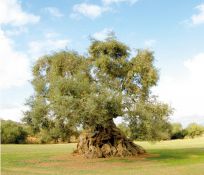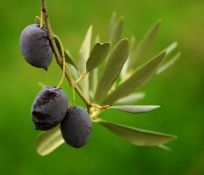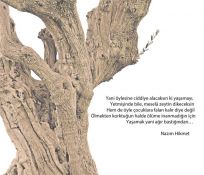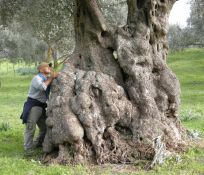Olive tree, also known as "the undying tree" in the history of mankind, directed the humankind through history as one of the most important milestones of human progress. The word "oil" which has different variations in all of the western languages originate from the word "eleia" which means olive tree in ancient Greek. Cultivation of olive started with the primitive man, and it is said that "Olea prima omnium arborum est...", "olive is the first of all trees." The importance of olive in human history is mentioned in all Holy Scriptures, books of genesis and origin stories. What is known about olive starts with an olive fossil, which dates back to 39 thousand years ago, found in Santorini Island of Greece. Although there are a lot of speculations about the birth place of olive and where it was first processed, in general it's accepted that this place is Anatolia's Hatay, Kahramanmaraş, Mardin regions.
According to legends;
Adam, who got banished from Heaven after eating the forbidden fruit with Eve, feels that he was going to die at the age of 930, and decides to ask God for forgiveness for himself and the whole humanity. He charges his son Seth with this task and sends him to the Garden of Eden. In response to Seth’s prayers the angel guarding the gates of Heaven gives Seth three seeds taken from the Tree of Knowledge of good and evil, and instructs him to place the seeds in Adam’s mouth before burying him. A short while later Adam dies, and gets buried in Hebron Valley near Mount Tabor. Three different trees sprout from where Adam was buried, which are Olive, Cedar, and Cypress. The peace between man and God was established.
According to Torah, olive is a symbol of abundance and wealth. Not only in Torah, but also in all the other holy scriptures and books olive tree has been a symbol of sacredness, abundance, justice, health, pride, victory, wealth, wisdom, intelligence, purity and rebirth, and the most important virtues and values for humanity.
During the Flood, to check whether the Flood is over or not, Noah releases a dove from the window of the Arc towards sunset. The dove returns back to the Arc, because the waters still didn’t subside. Noah releases the dove again after seven days. This time dove returns back with a freshly plucked olive leaf in its beak. This way Noah understands that the Flood is no more. The dove, which held the olive branch in its beak, has been the symbol of hope, abundance and peace ever since that day. The olive tree that survives the Flood has been the symbol of immortality.
In Old Testament, Olive Tree is said to be the king of all trees.
In ancient Egyptian faith, the olive tree was gifted to humanity in 6000 BC by the goddess of marriage, Isis. It represents the light of Ra, the god of sun. The discoveries about olive in ancient Egypt are based on the mill used to process olive which dates back to 4000 BC and hieroglyphs on pyramids about olive harvest which dates back to 2500 BC. Also, it is known that Egyptian Pharaoh Tutankhamun (1332-1323 BC) wore a crown of justice made out of olive leaves.
In Ancient Greek cult, the god or goddess who gifted the city with the most valuable present during the establishment of Athens would win the contest and become the protector of the city of Athens. Poseidon created a horse that could be used in sea battles and presented it to the council. The horse was dazzling with its speed and strength. Athena, the goddess of wisdom, science and crafts, gifted an olive branch. This tree would grow for years to come and live hundreds of years. From the fruit of the tree a liquid that could be used to cook was going to be obtained. This liquid would heal wounds, brighten the night, protect the people from heat with its shadow, and warm them as a firewood. Athena won the contest. The tree was planted in the acropolis. The olive tree, the symbol of peace, became the symbol of civilization and abundance as well. This myth is only one of many that tells the sacredness of olive and olive tree in Ancient Greece. According to Ancient Greeks, the most important indicator of a noble birth was to be born under an olive tree.
In addition to these, the epics Iliad and Odyssey written by Homer, who is believed to have lived in the 8th century BC, are full of rich descriptions and metaphors about olive tree and olive oil. Today, the travelers who visit Aegean shores of Anatolia can rest under the olive tree where Homer also sat under and can remember the words “ I belong to everyone and I belong to no one, I had been here before you came, I will be here after you leave”
The ancient Greek mythological hero Hercules, also known as Heracles, owned a weapon made out of olive tree.
This sacred tree played a part in all aspects of life. In ancient Greece, in accordance with the laws enacted by Solon of the Seven Sages, people who cut down olive trees were punished severely. This is the first known olive protection law in history. Hippocrates, considered as the father of modern medicine, advised people who couldn’t take a bath to at least rub their bodies with olive oil. Although they started using torches, the oil lamps that used olive oil were also commonly used household goods. Olive and olive oil have been the enlightenment for mankind. Olympics heroes were honored with olive branch crowns, and won olive oil that was processed from sacred olive trees.
Olive, cherished by people throughout the history due its economic value and multipurpose nature, played an integrative role in many cultures and contributed to Mediterranean economy’s development. Especially, olive oil trade has been an important factor to Roman Empire’s rise to power who spread the olive cultivation and oil production techniques.
Olive had been used as a symbol in Roman Empire, and Roman Emperor Caesar wore a crown of olive branches.
According to the Bible, a dove which carries an olive branch is interpreted as a vessel that carries the souls of the dead to God. In Paulus’s letter to the Romans, Jesus Christ used olive tree as a metaphor. Jesus Christ climbed the Mount of Olives to pray, and according to belief he was captured by the Romans here and crucified on a cross made out of an olive tree.
In Koran, it’s stated that the olive tree comes from Mount Sinai, from its fruits oil is processed and, this oil is used to add flavor to dishes. The olive tree is also mentioned in Surah An-Nur, Surah Al-An’Am, Surah An-Nahl, and in Surah At-Tin it is sworn upon by God by saying “by the fig, and the olive.”
In Anatolia, in Klazomenai Ancient City, located in Urla in the 7th and 6th centuries, old olive mills were found and these played an important part in the era’s trade.
Olive cultivation in Turkey, is present in all the regions except for Eastern Anatolia and Central Anatolia. Aydın, in Turkey, is number one in olive oil production and number three in table olive production.





